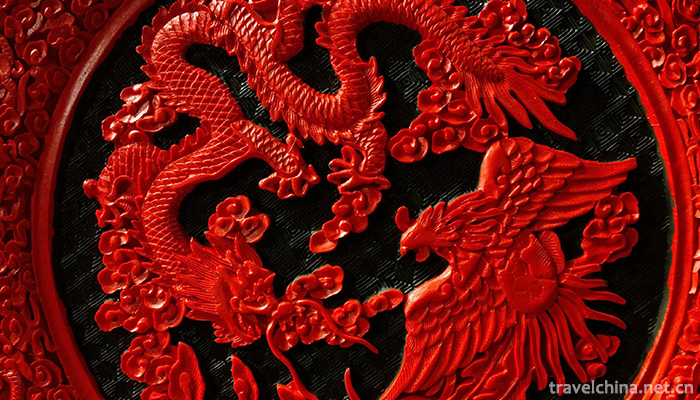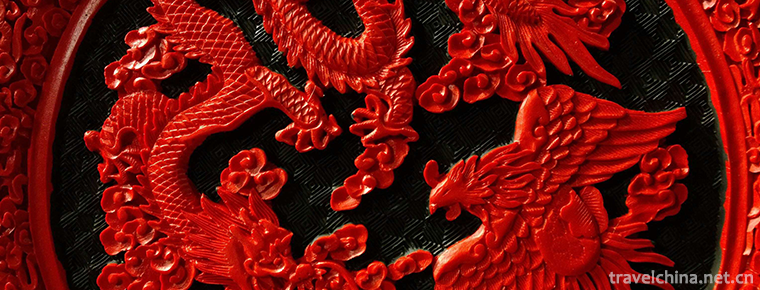Yangzhou lacquerware decoration skills
Yangzhou lacquerware decoration skills
Yangzhou lacquerware decoration technology, Jiangsu Province Yangzhou traditional handicraft, one of the national intangible cultural heritage.
Yangzhou lacquerware painting process is cumbersome, the step is "batch putty scrape gray, brush paint and push light". During the Warring States Period, Yangzhou lacquerware decoration technology began to appear. From Han Dynasty to Ming and Qing Dynasty, Yangzhou lacquerware decoration technology matured to its peak.
On May 20, 2006, Yangzhou lacquerware decoration technology was approved by the State Council of the People's Republic of China and listed in the first batch of national intangible cultural heritage list, item number_-52.
historical origin
As early as the Warring States Period, Yangzhou lacquerware decoration technology began to appear. From the unearthed objects, we can see that the shape and decoration technology of lacquerware at that time had a high level.
By the Han Dynasty, lacquerware was widely used in many fields, and its shape and decoration techniques were more exquisite and changeable. There are more than 10,000 Han lacquerware unearthed in the suburbs of Yangzhou City. Most of them are painted lacquerware with various types and rich patterns.
In the Tang Dynasty, Yangzhou bodiless dry lacquer, gold and silver flat lacquer, mole inlay and other techniques were quite mature. Lacquerware was listed as one of the 24 tributes.
During the Ming and Qing Dynasties, Yangzhou lacquer art flourished, with the emergence of red carving paint, flat grinding screw inlay, soft screw inlay, Baibao inlay and other varieties, forming a unique local style. During the reign of Qianlong, there were many streets named for lacquerware production in Yangzhou. The output and variety of lacquerware reached the highest level in history.
Technological characteristics
Yangzhou lacquerware products mainly include various kinds of screens, hanging screens, cabinets, tables and chairs, bottles and plates, bowls and boxes, tea sets, tobacco sets, four treasures of the study and tourist souvenirs.
There are ten kinds of craft decoration: carved lacquer inlaid with jade, flat grinding snail, point snail, pure carved lacquer, bone and stone inlaid, carved lacquer, carved filling, color painting, lacquer grinding painting, color lacquer inlaid with flat lacquer and so on. Among them, the most famous are Duobao inlaid lacquerware and molten lacquerware.
1. Duobao lacquerware
Duobao inlay is a unique kind of Chinese lacquerware craft, which was created by Zhou He, a famous craftsman in Jiajing period of Ming Dynasty. It chooses precious materials such as jadeite, ivory, agate, sapphire, white jade, hibiscus, cyanite, wood-to-stone, etc. and uses its natural color to carve and stitch on lacquerware, making the inlay of precious jade and lacquerware pearls seamless, complementing each other. It has the advantages of magnificence, richness, elegance and richness.
2. Mole lacquerware
Yangzhou snail lacquerware is divided into flat grinding snail lacquerware and point snail lacquerware. Flat-grinding mollusk is made of various kinds of shells, polished into thin sheets, with special tools to make a variety of figures, landscapes, terraces, pavilions, flowers, birds, insects, fish and other patterns, mosaic on the lacquer floor, and then polished by bun decoration. Its characteristics are bright as a mirror, clear black and white, clear and clear patterns, elegant and clean style. Point snail is a kind of high-quality shell, such as mussel shell, mica, noctilucent snail, which is grinded into 1/3 thin filaments equivalent to human hair, and then cut into tiny points, filaments and slices with special tools, which are embedded in the paint bottom bit by bit. There is time to use gold and silver slices, and then polished by bunting. Its style is colorful, brilliant rainbow, delicate and delicate, especially the edge of the snail works, often using meticulous two-way continuous pattern, making the works more decorative.
Technological process
Yangzhou lacquerware uses painting, drawing, hooking, carving, filling, carving, carving, grinding, inlaying, mosaic and other techniques in the process, which has a flat, bright, fine, even, gorgeous and elegant artistic expression effect. As the carrier of Yangzhou lacquer art, the variety of lacquerware is determined by the decorative techniques (i.e. decorative techniques). In the Book of Hou Decoration, "Hou" means painting and "decoration" means decoration. However, before decoration, lacquer embryos are made from lacquer, tire and paint.
The main lacquers are natural lacquer and cashew nut lacquer. The surface of the lacquer and the decoration are also refined polishing lacquer. The finish coat is also made of chemical synthetic lacquer. The bottom tire is the shape of lacquerware. Although Yangzhou lacquerware has a wide variety of materials, such as copper, calcium and plastic tires, as well as the use of linen, fiberglass reinforced plastics and other production needs customized tire, but most of them are daily necessities, so mainly wooden tires.
Batch of putty: commonly used pork blood greasy and cattle paint greasy, thick mud paste can seal up the wood grain, shade dry after grinding flat. The process of painting is very tedious, but it decides whether or not to get a smooth paint embryo: basically a few sudden for "batch of putty scrape gray, brush paint, push light".
Scraping ashes: Paint ashes are evenly smeared in the order of coarse, medium and fine ashes, and each time they are smeared, they are baked by sunlight or infrared lamp for ten and then ground half. Different lacquerware has different grey floor thickness, carved lacquerware and inlaid lacquerware should be thick, painted lacquerware and hook lacquerware should be thin, and carved lacquerware should not be grey floor.
Painting: Except for carving lacquerware, which is painted with large lacquer and polished after shade drying every time, the other lacquerware is uniformly painted with cashew nut paint or polishing paint according to the sequence of down-coating, middle-coating and top-coating. After shade drying every time, it can be polished smoothly before various forms of decoration can be carried out. Different lacquerware requires different steps of painting.
Pushing: When the decoration on the lacquer embryo is finished, besides Baibao inlay and carving lacquer, the other lacquer wares need to be polished and polished after covering with chemical paint, so as to make the surface of the lacquer shiny.
Inheritance and Protection
Inheritance value
Yangzhou lacquerware is a traditional special handicraft in China. It has a long history, complete varieties, exquisite skills, unique style, and is well known at home and abroad.
After more than 2,000 years of pursuit by famous masters, lacquerware decoration technology is becoming more and more perfect, its style is fresh, elegant and gorgeous. Huanfu Oriental charm has become an important school of Chinese traditional lacquerware art. Contemporary Yangzhou lacquerware still occupies a pivotal position in the national lacquerware industry.
Current situation of inheritance
Due to the long training period and low income of lacquerware practitioners, there is a talent gap in Yangzhou lacquerware industry under the condition of market economy. In contemporary life, great changes have taken place in people's aesthetic concepts. The social needs and aesthetic values of lacquerware have gradually weakened, resulting in the shrinkage of the lacquerware market and the crisis of the survival of the lacquer industry. Therefore, it is necessary to protect Yangzhou lacquerware skills so that they can continue to be inherited in modern society.
Heritage figures
Zhang Yu, male, born in January 1944 in Yangzhou, Jiangsu Province. In June 2007, Zhang Yu was selected as the representative successor of the first batch of national intangible cultural heritage projects, which was declared by Yangzhou City, Jiangsu Province. Project Name: Yangzhou lacquerware decoration skills.
Zhao Rubai, male, born in August 1939 in Hongze, Jiangsu Province. In June 2007, Zhao Rubai was selected as the representative successor of the first batch of national intangible cultural heritage projects, which was declared by Yangzhou City, Jiangsu Province. Project Name: Yangzhou lacquerware decoration skills.
protective measures
Yangzhou Lacquerware Factory took the lead in setting up a working group on national standard declaration, and the national standard "General Technical Requirements for Lacquer Communicators" drafted under its chair was officially implemented on December 1, 2014. Lacquer flower is an old Chinese brand and a well-known trademark in China. Chen Qiurong, the first doctor of Chinese lacquer art specialty, was introduced. The technology of Yangzhou lacquer made from the essence of traditional culture combines with elements of modern civilization and produces a series of Arts and crafts closely related to modern life.
social influence
Domestic impact
In 1959, artists Liang Guohai and Wang Guozhi selected painter Chen Zhifo's drawings, and some young artists elaborately produced "Spring of Peace" and "Magpie Dengmei" hanging screens, which are still displayed in the Jiangsu Hall of the Great Hall of the People in Beijing. Yangzhou Lacquerware Factory has won many international and domestic gold medals, and many representative works have been selected as national ceremonies or displayed in Beijing Great Hall of the People, Diaoyutai State Guest House and other important places.
international repercussions
In 1983, when General Secretary Hu Yaobang visited Japan, he presented the multi-treasured lacquer-inlaid screen "Songhe Yannian" to the Emperor of Japan.


-
1.Yunlong Lake
Located in the southwest of Xuzhou City, Jiangsu Province, Yunlong Lake is the main scenic spot of Yunlong Lake Scenic Area in Xuzhou, formerly known as "Stone Dog Lake"
Time 2018-12-06 -
2.Buluotuo
Buluotuo, the traditional folk literature of Ganzhuang Mountain in Baise, Guangxi, China, is one of the national intangible cultural heritages.
Time 2018-12-15 -
3.Nanning Rural World
Nanning Rural World is a large-scale eco-leisure resort built by Nanning Weining Eco-Park Co., Ltd. alone. It is a national AAAA tourist attraction with good ecological environment and high negative o
Time 2018-12-27 -
4.Ziweidong Scenic Area
Seeing the pronoun of the first reaction of "purple cave" to "immortal" cultivation and residence, we often enchase that fairyland dream on this name.
Time 2019-03-22 -
5.Haizi Opera
Hezi Opera is one of the traditional operas in Anhui Province. It was named after the pronunciation of the word "sea". It is popular in some areas of Anhui and Henan
Time 2019-05-03 -
6.Encouragement of Miao Nationality in Western Hunan
Encouraged by the Miao people in Western Hunan Province, the traditional dance of Tujia and Miao Autonomous Prefecture in Western Hunan Province is one of the national intangible cultural heritage.
Time 2019-07-03 -
7.Yongxin Drum
Yongxin Xiaogu is one of the traditional operas in Ji'an City, Jiangxi Province, which originated from Taoism. Legend has it that it was formed in Yongxin, Jiangxi Province during the reign of Qingdao
Time 2019-07-14 -
8.Zhuang medicine thread moxibustion therapy
Zhuang medicine is the traditional medicine of the Zhuang people. It is a national traditional medicine based on the ancient Luoyue culture and Lingnan culture, with Yin and Yang as its foundation, Qi
Time 2019-08-16 -
9.Guan Yu
Guan Yu(? - 220 years), the word is long, then changed word cloud length. Hedong County Jie county (today) Shanxi Yuncheng People are called "beauty beard Gong". Early follow Liu Bei In the
Time 2019-09-07 -
10.A er la bo er shu
Al r Bo Er (1162 to 1226) , Mongolia Famous general, Genghis Khan "Four Jun" is the leader of the founding fathers. Formerly known as "Er Chu". As a result of helping the young boy
Time 2019-09-14 -
11.Anhui University Of Technology
Anhui University of Technology is located in Anhui province. Ma'anshan The city is a multi-disciplinary university characterized by industry and industry. Ministry of science and technology With the s
Time 2019-10-10 -
12.Yamugou scenic spot
Yamugou scenic spot is located on the Bank of Taiping River (a famous scenic spot in Guizhou Province) in Jiangkou County, Tongren City, Guizhou Province, adjacent to Fanjing Mountain (National Nature Reserve, China's top ten famous summer resort).
Time 2020-10-13